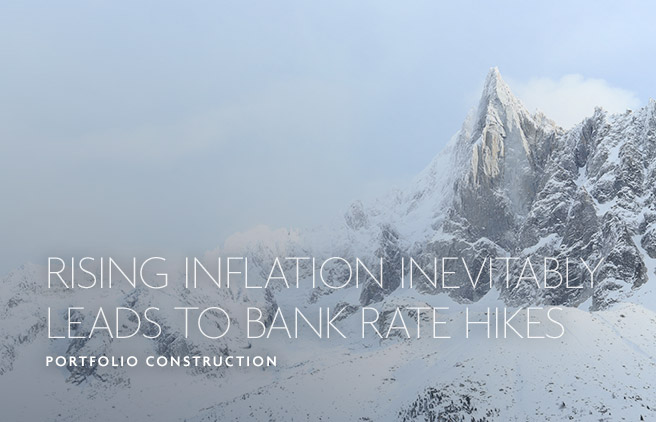
Rising Inflation Inevitably Leads to Bank Rate Hikes
Inflation and interest rates continue dominating news headlines as we begin 2022. Supply chain disruptions and higher oil prices have contributed to inflation recently topping 7% in the U.S. and 4.7% in Canada. It’s widely expected the Fed and Bank of Canada will raise interest rates soon to combat inflation. Senior Vice President and Chief Investment Officer Alfred Lam, explores the effect rate hikes could have on economic growth, markets and investment decisions during the year ahead.
The main topic as we enter 2022 are inflation and interest rates. US inflation, as measured by Consumer Price Index (CPI), topped 7% in December. The last reported figure for Canada was 4.7% for the annual rate as of November. Supply chain disruptions drove cost of durables like used car prices higher. In many cases, used car prices are even higher than the manufacturer’s suggested retail price of new cars dealerships struggled to build inventory. Higher crude oil price led to inflating gasoline prices at the pump. Food is more expensive as labour and transportation costs have increased. The good news is wages are increasing as labour market is very tight. We had a few aggressive price hikes in April to July; until we drop those months from the annual rate calculation, the reported annual inflation will remain elevated. We expect the monthly rate to average 0.3-0.5% in near future; if we are correct, we may finish 2022 with a 4% inflation.
The only time we will see inflation falling back to 2% is likely during recession as the world is fundamentally different than the last decade. To name a few: 1) money is supply is significantly more, 2) we are re-building our economies for lower carbon footprint, which include additional investment and ironically more oil consumption 3) labour cost in China has increased. As inflation rises, we would expect interest rates to increase to compensate savers for loss of purchasing power. However, central banks have generally been slow. They wanted the economy to run “hot” before hiking. As unemployment rates drop and economic growth quicken significantly following the very brief recession in 2020, the markets widely expect the US Federal Reserve and Bank of Canada to hike in the first quarter of this year. The question many of us ask is will this hike cycle destroy the stock market momentum? The answer depends on the pace and the terminal rates but not the timing of the first hike. Terminal rate is the maximum central bank lending rate could before economy dips into recession. During a normal cycle, that rate could be as high as 5%. Since the global financial turmoil, we have been living in “new normal” – debt is significantly larger, rates are lower. The last cycle the fed funds rate peaked at 2.75% in US in 2018. With even more debt following the start of the pandemic, we estimate the terminal rate to be 2-2.5%, and most likely on the low end of the range.
Our best guess is the central banks will take their time to hike. Given large size of debt, the impact of each 25 basis points hike will be more pain than normal. In Canada, mortgage is significant portion of every household’s expenditure. The first few hikes will be more acceptable/tolerable. This means the pace will be quicker initially and fades. All in all, it may take 2 to 3 years to get to 2%. It is important to note even as we reach the terminal rates, interest income is still below inflation. Investors will continue to favour equity as we need growth to compensate the income shortfall. Because recession might be years away, corporate earnings may continue to grow, and most likely well above inflation and their higher borrowing cost. There are also sectors that are less sensitive to rates as demand is inelastic. For example, utility, staples, health care and tech. We would favour health care and tech as both sectors also have growth profile. Inflation and interest rates will no doubt affect our living but the impact to investments will likely be noise.
 By Alfred Lam, CFA, Senior Vice-President and Chief Investment Officer, CI GAM | Multi-Asset Management
By Alfred Lam, CFA, Senior Vice-President and Chief Investment Officer, CI GAM | Multi-Asset Management
This document is intended solely for information purposes. It is not a sales prospectus, nor should it be construed as an offer or an invitation to take part in an offer. This report may contain forward-looking statements about one or more funds, future performance, strategies or prospects, and possible future fund action. These statements reflect the portfolio managers’ current beliefs and are based on information currently available to them. Forward-looking statements are not guarantees of future performance. We caution you not to place undue reliance on these statements as a number of factors could cause actual events or results to differ materially from those expressed in any forward-looking statement, including economic, political and market changes and other developments. CI Assante Wealth Management and its dealer subsidiaries, Assante Capital Management Ltd. and Assante Financial Management Ltd. (collectively “Assante”) are affiliates of CI GAM | Multi-Asset Management, which is a division of CI Global Asset Management. Evolution Private Managed Accounts are managed by CI Global Asset Management under the United Financial brand and are available exclusively through your Assante advisor. Neither CI Global Asset Management nor its affiliates or their respective officers, directors, employees or advisors are responsible in any way for damages or losses of any kind whatsoever in respect of the use of this report. Commissions, trailing commissions, management fees and expenses may all be associated with investments in mutual funds and the use of the Asset Management Service. Any performance data shown assumes reinvestment of all distributions or dividends and does not take into account sales, redemption or optional charges or income taxes payable by any securityholder that would have reduced returns. Mutual funds are not guaranteed, their values change frequently and past performance may not be repeated. Please read the fund prospectus and consult your advisor before investing. CI Assante Wealth Management is a registered business name of Assante Wealth Management (Canada) Ltd. CI Global Asset Management is a registered business name of CI Investments Inc. This report may not be reproduced, in whole or in part, in any manner whatsoever, without prior written permission of CI Assante Wealth Management. Copyright © 2021 CI Assante Wealth Management. All rights reserved.
Inflation and interest rates continue dominating news headlines as we begin 2022. Supply chain disruptions and higher oil prices have contributed to inflation recently topping 7% in the U.S. and 4.7% in Canada. It’s widely expected the Fed and Bank of Canada will raise interest rates soon to combat inflation. Senior Vice President and Chief Investment Officer Alfred Lam, explores the effect rate hikes could have on economic growth, markets and investment decisions during the year ahead.
The main topic as we enter 2022 are inflation and interest rates. US inflation, as measured by Consumer Price Index (CPI), topped 7% in December. The last reported figure for Canada was 4.7% for the annual rate as of November. Supply chain disruptions drove cost of durables like used car prices higher. In many cases, used car prices are even higher than the manufacturer’s suggested retail price of new cars dealerships struggled to build inventory. Higher crude oil price led to inflating gasoline prices at the pump. Food is more expensive as labour and transportation costs have increased. The good news is wages are increasing as labour market is very tight. We had a few aggressive price hikes in April to July; until we drop those months from the annual rate calculation, the reported annual inflation will remain elevated. We expect the monthly rate to average 0.3-0.5% in near future; if we are correct, we may finish 2022 with a 4% inflation.
The only time we will see inflation falling back to 2% is likely during recession as the world is fundamentally different than the last decade. To name a few: 1) money is supply is significantly more, 2) we are re-building our economies for lower carbon footprint, which include additional investment and ironically more oil consumption 3) labour cost in China has increased. As inflation rises, we would expect interest rates to increase to compensate savers for loss of purchasing power. However, central banks have generally been slow. They wanted the economy to run “hot” before hiking. As unemployment rates drop and economic growth quicken significantly following the very brief recession in 2020, the markets widely expect the US Federal Reserve and Bank of Canada to hike in the first quarter of this year. The question many of us ask is will this hike cycle destroy the stock market momentum? The answer depends on the pace and the terminal rates but not the timing of the first hike. Terminal rate is the maximum central bank lending rate could before economy dips into recession. During a normal cycle, that rate could be as high as 5%. Since the global financial turmoil, we have been living in “new normal” – debt is significantly larger, rates are lower. The last cycle the fed funds rate peaked at 2.75% in US in 2018. With even more debt following the start of the pandemic, we estimate the terminal rate to be 2-2.5%, and most likely on the low end of the range.
Our best guess is the central banks will take their time to hike. Given large size of debt, the impact of each 25 basis points hike will be more pain than normal. In Canada, mortgage is significant portion of every household’s expenditure. The first few hikes will be more acceptable/tolerable. This means the pace will be quicker initially and fades. All in all, it may take 2 to 3 years to get to 2%. It is important to note even as we reach the terminal rates, interest income is still below inflation. Investors will continue to favour equity as we need growth to compensate the income shortfall. Because recession might be years away, corporate earnings may continue to grow, and most likely well above inflation and their higher borrowing cost. There are also sectors that are less sensitive to rates as demand is inelastic. For example, utility, staples, health care and tech. We would favour health care and tech as both sectors also have growth profile. Inflation and interest rates will no doubt affect our living but the impact to investments will likely be noise.
 By Alfred Lam, CFA, Senior Vice-President and Chief Investment Officer, CI GAM | Multi-Asset Management
By Alfred Lam, CFA, Senior Vice-President and Chief Investment Officer, CI GAM | Multi-Asset Management
This document is intended solely for information purposes. It is not a sales prospectus, nor should it be construed as an offer or an invitation to take part in an offer. This report may contain forward-looking statements about one or more funds, future performance, strategies or prospects, and possible future fund action. These statements reflect the portfolio managers’ current beliefs and are based on information currently available to them. Forward-looking statements are not guarantees of future performance. We caution you not to place undue reliance on these statements as a number of factors could cause actual events or results to differ materially from those expressed in any forward-looking statement, including economic, political and market changes and other developments. CI Assante Wealth Management and its dealer subsidiaries, Assante Capital Management Ltd. and Assante Financial Management Ltd. (collectively “Assante”) are affiliates of CI GAM | Multi-Asset Management, which is a division of CI Global Asset Management. Evolution Private Managed Accounts are managed by CI Global Asset Management under the United Financial brand and are available exclusively through your Assante advisor. Neither CI Global Asset Management nor its affiliates or their respective officers, directors, employees or advisors are responsible in any way for damages or losses of any kind whatsoever in respect of the use of this report. Commissions, trailing commissions, management fees and expenses may all be associated with investments in mutual funds and the use of the Asset Management Service. Any performance data shown assumes reinvestment of all distributions or dividends and does not take into account sales, redemption or optional charges or income taxes payable by any securityholder that would have reduced returns. Mutual funds are not guaranteed, their values change frequently and past performance may not be repeated. Please read the fund prospectus and consult your advisor before investing. CI Assante Wealth Management is a registered business name of Assante Wealth Management (Canada) Ltd. CI Global Asset Management is a registered business name of CI Investments Inc. This report may not be reproduced, in whole or in part, in any manner whatsoever, without prior written permission of CI Assante Wealth Management. Copyright © 2021 CI Assante Wealth Management. All rights reserved.





